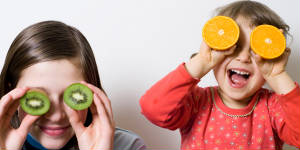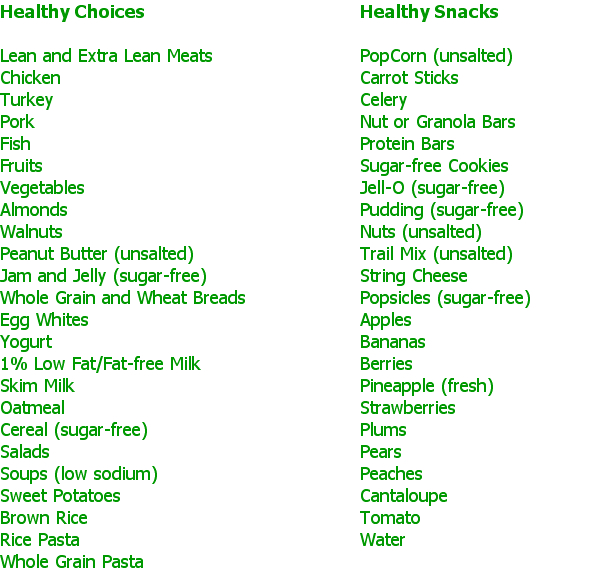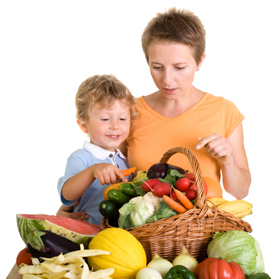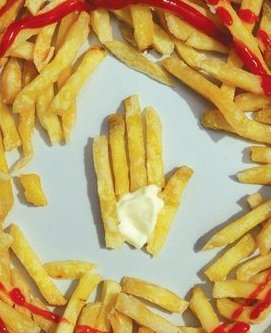EAT
IT! HEALTHY
FOOD CHOICES
The key and foundation to Healthy
For Life - Eat It!, Move It!, Live It! is eating healthy foods that are good for you and your body. One of the greatest features of Healthy
For Life - Eat It!, Move It!, Live It! is the ability to replace poor, unhealthy food choices, with smarter,
healthier choices. Nearly every unhealthy food can be replaced with a similiar healthy choice. One of the greatest features of Healthy
For Life - Eat It!, Move It!, Live It! is the ability to replace poor, unhealthy food choices, with smarter,
healthier choices. Nearly every unhealthy food can be replaced with a similiar healthy choice. Healthy For Life - Eat It!, Move It!,
Live It! makes it easy to enjoy healthy food choices for each and every meal - breakfast, lunch and dinner,
as well as snacktime. At home, on the go, or in restaurants, Healthy For Life - Eat It!, Move It!, Live It! shows
you how easy it is to change poor eating habits by providing you with the truths, facts, misconceptions and the proper information
you need to know to make healthier choices Healthy For Life - Eat It!, Move It!, Live It! is
not a diet - diets don't work. This is a safe, healthy way to enjoy the foods you love, eat when you are hungry, and have
the confidence in enjoying foods that are good for you, taste great, and will keep you Healthy For Life! Here are just a few examples of some healthy choices for meals and snacks:
There are many great tasting, healthy choices which can easily be
added, adapted or used to replace less healthy foods. These still offer you a wide variety of foods from which to choose,
all of which are just as easy to find at your local grocery store or favorite restaurants. Here are just some favorite
examples:

 Healthy For Life - Eat It!, Move It!,
Live It! By The Numbers
How Many Calories Do Kids Need?
This is a question asked by kids as well as parents. While there
are many variables such as age and size, each person's body burns calories (energy) at different rates, so there isn't one
set number of calories that a child should eat. We do suggest a recommended range for most school-age kids: 1,600 to 2,500
per day. (average about 2000 day)
As preteens or teens reach puberty, boys and girls both need more calories. While
girls may tend to need fewer calories than boys, as boys enter puberty they will need as many as 2,500+ calories per day.
But whether girls or boys, kids who are active, move around a lot, and play sports will need more calories than kids who don't.
Calorie Needs of School Age Kids
School-aged children from age 6 until they become teenagers,
need to eat about 2,000 calories of healthy foods each day.
Calorie Needs of Teens
Teenagers
need to consume more calories than at any other time in their lives. Teenage boys need anywhere from 2,500 to 3,000 calories
per day to help them grow and develop properly. Boys who are very active in sports may need even more calories in their diet.
Teen girls need to consume about 2,200 calories per day. Teen girls who play sports and are very active may also need more
calories. Teens, who are typically known for unhealthy eating habits and eating poorly, should be most concerned and encouraged
to adapt good eating and physical activity habits during these crucial years.
 How The Body Uses Calories How The Body Uses Calories
Many people
mistakenly believe they have to burn off all the calories they eat or they will gain weight. This isn't true. Your body needs
some calories just to operate properly, remain healthy and grow. The calories your body doesn’t use or burn is what
is stored and can become unhealthy weight gain. Food Enemies
The main food enemies which you should always be most concerned about include
foods that are high in Sugar, Salt, Fat & White Flour. These are the areas of which you should be aware and of most concern:
 Calories
Fat
Carbohydrates
(sugar, starches)
Sodium (salt)
While these may be part of healthy eating in limited amounts necessary for our body, these are the main areas that most
often lead to unhealthy weight gain. As detailed in our book, it is important to know the proper amounts of each of these
and what is considered unnecessary or in excess.
 The amount of these “enemies” can be found in reading
the food labels on foods, and by the knowledge of which foods are low in each of these contents. These can easily be replaced
with healthier versions containing whole grain instead of white flour, fat-free or reduced fat, reduced sodium or fresh foods,
and low carb alternatives. The amount of these “enemies” can be found in reading
the food labels on foods, and by the knowledge of which foods are low in each of these contents. These can easily be replaced
with healthier versions containing whole grain instead of white flour, fat-free or reduced fat, reduced sodium or fresh foods,
and low carb alternatives. Read The Labels - The Information You Need To Know You get the facts about foods, their ingredients and contained amounts by reading the food label required by our
government. This label provides you with a breakdown of the amount of contents of the food. NOTE: Be aware that the amounts
of the label may not be for the entire contents of the food in the package. The breakdown on the label may be for only a specified
serving amount. To learn about the serving size look at the very top of the label for serving size information and the number
of servings per container or package. Here is an example of a typical food label:
Selecting the right foods and making healthy choices can be easy and fun, once you know the proper information. You
will be amazed at how much bad or unhealthy amounts of ingredients and additives are in many of the foods you normally eat.
By just taking this basic information, combined with the proper portion sizes, balance and moderation, you will find grocery
shopping, cooking and eating healthy is very easily obtainable for the rest of your life.
|
|
|
|